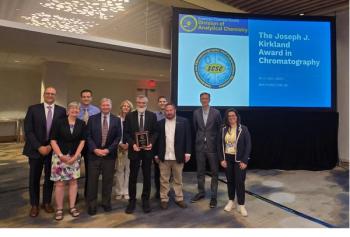
Extraction Using Hyper-Cross-Linked Polymers as Sorbents Assists HPLC-UV Detection of Nitroimidazoles
Samples of honey, chicken breast, and environmental water were analyzed for residue of nitroimidazoles, which are common antibiotics but can have detrimental effects on humans.
Research based out of Hebei University and Hebei Agricultural University, both in Baoding, China, has demonstrated the use of a heteroatom-rich hyper-cross-linked polymer (HCP) as an adsorbent for sensitive solid-phase extraction (SPE) followed by high performance liquid chromatography with an ultraviolet (UV) detector (HPLC-UV) for the determination of nitroimidazole (NDZ) residue (1).
The study published in the Journal of Chromatography A analyzed samples of honey, chicken breast, and water from Taihang Lake in Baoding to detect NDZs, which the researchers defined as among a group of antibiotics commonly used to prevent or treat infections involving anaerobic bacteria. NDZ residue, the study said, can make it into the food chain and cause undue carcinogenic, mutagenic, or toxic effects in humans.
Previous attempts at detecting NDZs have made use of gas chromatography (GC), spectrophotometry, or high performance liquid chromatography (HPLC) either alone or coupled to mass spectrometry (HPLC–MS), with either solid-phase or liquid-liquid extraction (SPE, LLE, respectively) most often used to isolate low-content target analytes, SPE being the prevailing option of the two (1).
Meanwhile, hyper-cross-linked polymers (HCP) are defined by the researchers as one class of porous organic polymers (POP) characterized by high specific surface area, good thermal stability, and adjustable pore size. An HCP constructed with a porphyrin structural unit, which they said would have an “extended π-π conjugated structure” with heteroatoms that enhanced interaction between adsorbent and analytes, was created for purposes of this study by a Friedel-Craft reaction with 5,10,15,20-tetraphenylporphyrin (TPP) and 4,4’-Bis(chloromethyl)-1,1’-biphenyl (BCMBP) as the monomer (1).
The team reported “satisfactory” results for the quantification of five commonly used NDZs within the designated samples, namely dimethylimidazole, metronidazole, ornidazole, ronidazole, and secnidazole. Limits of detection for these NDZs, based on a signal-to-noise (S/N) ratio of 3, were measured to be 0.02–0.04 ng/mL, 0.4–1.0 ng/g, and 0.5–0.7 ng/g for the water, honey, and chicken, respectively, with determination coefficients from 0.9933 to 0.9998 (1). Analyte recoveries were 91.1% to 102.7% for the water, 83.2% to 105.0% for the honey, and 85.9% to 103.0% for the chicken, according to the study, with relative standard deviations less than 10%.
To the extent that new methods of analysis are being desired for the determination of NDZs in environmental samples to provide better information about their threat to human health when over-relied upon, the HCP-TPP-BCMBP adsorbent for solid-phase extraction of nitroimidazoles, especially when followed by HPLC-UV detection, was considered an “excellent” option by the authors of this study, and they plan to conduct further research to expand the scope of the method’s potential applications (1).
Reference
(1) Wang, J.; Liu, J.; Liu, W.; et al. Porphyrin-based hypercrosslinked polymers as sorbents for efficient extraction of nitroimidazoles from water, honey and chicken breast. J. Chromatogr. A 2023, 1702, 464087. DOI:
Newsletter
Join the global community of analytical scientists who trust LCGC for insights on the latest techniques, trends, and expert solutions in chromatography.





